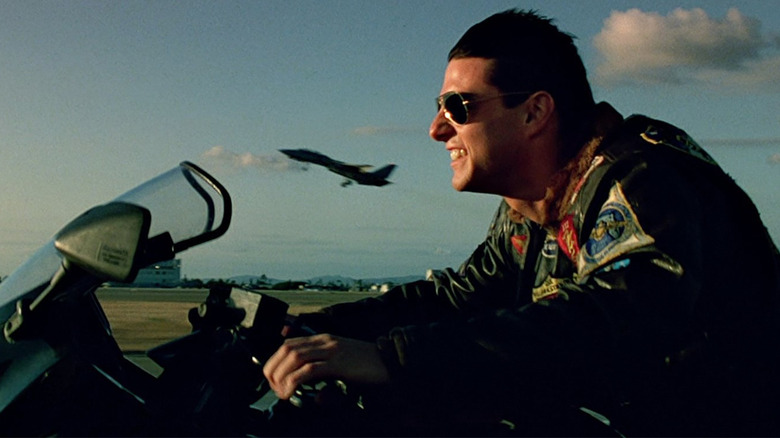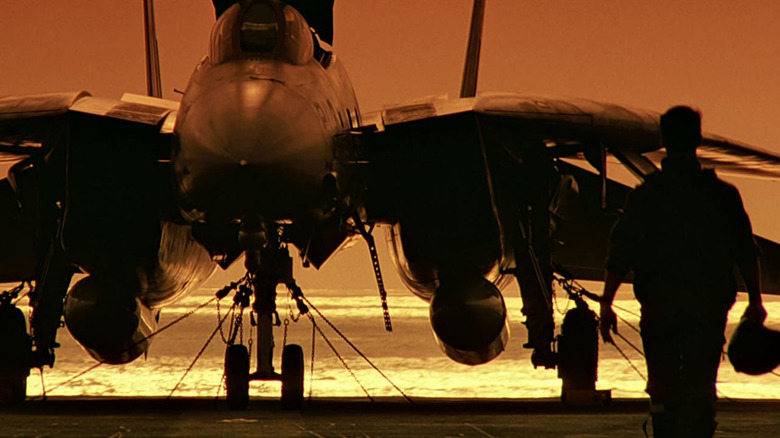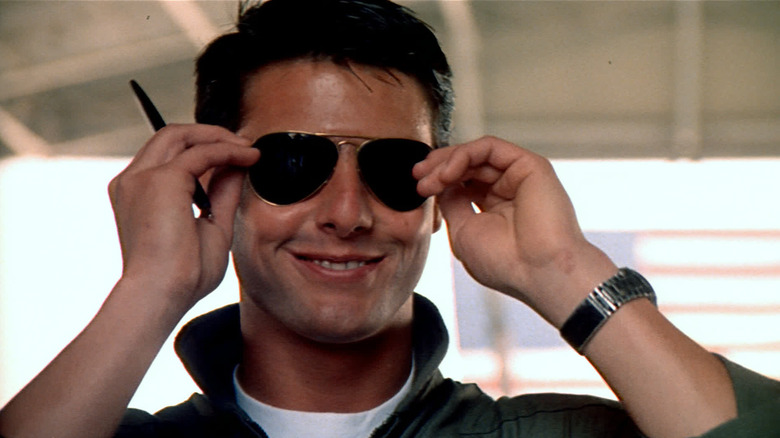Tony Scott's Wallet Got A Workout Behind The Scenes Of Top Gun
The 1980s have become coalesced in America's cultural memory as a decade of excess above all else. Sure, the era produced a number of notably kooky, how-did-that-ever-happen trends in fashion, music, and pop culture, but permeating just about everything is the sense of largesse, which in turn has helped the decade's style remain so iconic. In other words, nothing about the '80s was subtle.
One of the least subtle blockbusters of the decade is 1986's "Top Gun." The film is almost aggressively excessive, with a wall-to-wall pop rock soundtrack filled with big names like Kenny Loggins and Cheap Trick blaring under shots of Tom Cruise, Val Kilmer, Anthony Edwards and the rest of the big screen pilots zooming through the sky in real F-14 jet fighters as they compete for a trophy that proves they're the best pilot in the country. If all those shots of aircraft executing real maneuvers look complicated and expensive, that's because it was.
Director Tony Scott could've relied on an effects company building models and miniatures of aircraft, but he was determined to capture the real thing on camera. The choice not only resulted in the production having to shell out some serious cash, but in one instance, Scott himself had to cough up a considerable amount of dough in order to capture some sweet, sweet fighter jet footage.
Scott feels the need for speed...and expensive course changes
According to Scott's commentary on home media releases of "Top Gun" (via No Film School), the director was originally thinking the film should at least look moody, along the lines of films like"Apocalypse Now," but producers Don Simpson and Jerry Bruckheimer disagreed. While Scott eventually embraced the more upbeat and borderline jingoistic tone of the film, he still wanted to shoot it his way.
On the days of principal photography when Scott was capturing footage onboard a real aircraft carrier out at sea, he recalled how he was shooting "in slow motion with graduated filters...that was sort of artsy and dark and again esoteric, and Paramount saw these dailies when I was still on the aircraft carrier, and they panicked." The studio banned him from shooting any more slow-motion shots.
Scott disobeyed and kept shooting, resulting in his being fired from the film. However, he and the crew were still on the carrier and were kept in place by the weather, so he kept shooting. One shot involved the launching of fighters from the carrier deck while backlit by the sun, capturing footage so striking that Scott would eventually use it for the film's tone-setting opening sequence. However, the ship changed course, changing the perfect lighting scheme.
According to a story told by Cruise at Scott's funeral (as well as an interview with the director on the DVD), Scott asked the carrier captain to change course and speed to accommodate the shot, changes that the commander explained would cost $25,000. Scott then got out his checkbook, wrote the captain a personal check for that amount, and kept shooting. Whether or not that check eventually bounced, as Scott liked to allege, the filmmaker got his shots and was eventually rehired. It seems all too appropriate that the director got "Top Gun" made by following the lead of its maverick main character.
Top Gun launches more than jets
Nowadays, names like Tom Curise, Tony Scott, Don Simpson, and Jerry Bruckheimer read like Hollywood royalty, but it wasn't until the success of "Top Gun" that those men achieved such status. Simpson and Bruckheimer were the most successful of that group going into the film, producing hits like "Flashdance" and "Beverly Hills Cop." Yet it was "Top Gun" that cemented their names as blockbuster makers, and the two would go on to be involved with some of the biggest hits of the '90s.
Cruise was already a well-known actor, too, but aside from 1983's "Risky Business," he hadn't had a major hit until "Top Gun." Almost immediately following his turn as Pete "Maverick" Mitchell in the film, he made hit after hit, becoming one of the decade's top leading men. Scott thought his career was over after the critical drubbing he got for his debut feature, 1983's "The Hunger," yet the success of "Top Gun," along with his relationship with Simpson and Bruckheimer, put him on the A-list for the rest of his life.
In addition to properly launching all those careers, "Top Gun" also established a slick, commercial and excessive style for Simpson and Bruckheimer's productions. That style would be adopted by several other filmmakers in the years that followed, including a young director of advertisements who the producers themselves would hire in the mid-'90s: Michael Bay. Bay's movies would further raise the bar of excess on screen, a bar that only a few others have managed to match (or top). Today's climate of blockbuster films furiously trying to be the loudest, fastest, and largest (which "Top Gun's" legacy sequel, "Maverick," will duly attempt this month) is due to a number of factors, but its origins can certainly be traced back to Tony Scott and "Top Gun."


